Related Research Articles
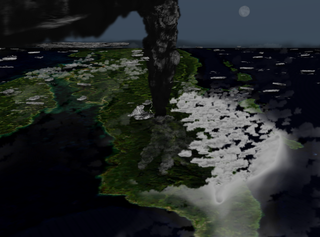
The Toba eruption was a supervolcano eruption that occurred around 74,000 years ago during the Late Pleistocene at the site of present-day Lake Toba in Sumatra, Indonesia. It is one of the largest known explosive eruptions in the Earth's history. The Toba catastrophe theory holds that this event caused a severe global volcanic winter of six to ten years and contributed to a 1,000-year-long cooling episode, leading to a genetic bottleneck in humans.

The volcanic winter of AD 536 was the most severe and protracted episode of climatic cooling in the Northern Hemisphere in the last 2,000 years. The volcanic winter was caused by at least three simultaneous eruptions of uncertain origin, with several possible locations proposed in various continents. Most contemporary accounts of the volcanic winter are from authors in Constantinople, the capital of the Eastern Roman Empire, although the impact of the cooler temperatures extended beyond Europe. Modern scholarship has determined that in early AD 536, an eruption ejected massive amounts of sulfate aerosols into the atmosphere, which reduced the solar radiation reaching the Earth's surface and cooled the atmosphere for several years. In March 536, Constantinople began experiencing darkened skies and lower temperatures.

A volcanic winter is a reduction in global temperatures caused by droplets of sulfuric acid obscuring the Sun and raising Earth's albedo (increasing the reflection of solar radiation) after a large, sulfur-rich, particularly explosive volcanic eruption. Climate effects are primarily dependent upon the amount of injection of SO2 and H2S into the stratosphere where they react with OH and H2O to form H2SO4 on a timescale of a week, and the resulting H2SO4 aerosols produce the dominant radiative effect. Volcanic stratospheric aerosols cool the surface by reflecting solar radiation and warm the stratosphere by absorbing terrestrial radiation for several years. Moreover, the cooling trend can be further extended by atmosphere–ice–ocean feedback mechanisms. These feedbacks can continue to maintain the cool climate long after the volcanic aerosols have dissipated.

Eldgjá is a volcano and a canyon in Iceland. Eldgjá is part of the Katla volcano; it is a segment of a 40 kilometres (25 mi) long chain of volcanic craters and fissure vents that extends northeast away from Katla volcano almost to the Vatnajökull ice cap. This fissure experienced a major eruption around 939 CE, which was the largest effusive eruption in recent history. It covered about 780 square kilometres (300 sq mi) of land with 18.6 cubic kilometres (4.5 cu mi) of lava from two major lava flows.

Mount Takahe is a 3,460-metre-high (11,350 ft) snow-covered shield volcano in Marie Byrd Land, Antarctica, 200 kilometres (120 mi) from the Amundsen Sea. It is a c. 30-kilometre-wide (19 mi) mountain with parasitic vents and a caldera up to 8 kilometres (5 mi) wide. Most of the volcano is formed by trachytic lava flows, but hyaloclastite is also found. Snow, ice, and glaciers cover most of Mount Takahe. With a volume of 780 km3 (200 cu mi), it is a massive volcano; the parts of the edifice that are buried underneath the West Antarctic Ice Sheet are probably even larger. It is part of the West Antarctic Rift System along with eighteen other known volcanoes.
Huaynaputina is a volcano in a volcanic high plateau in southern Peru. Lying in the Central Volcanic Zone of the Andes, it was formed by the subduction of the oceanic Nazca Plate under the continental South American Plate. Huaynaputina is a large volcanic crater, lacking an identifiable mountain profile, with an outer stratovolcano and three younger volcanic vents within an amphitheatre-shaped structure that is either a former caldera or a remnant of glacial erosion. The volcano has erupted dacitic magma.

The Minoan eruption was a catastrophic volcanic eruption that devastated the Aegean island of Thera circa 1600 BCE. It destroyed the Minoan settlement at Akrotiri, as well as communities and agricultural areas on nearby islands and the coast of Crete with subsequent earthquakes and paleotsunamis. With a Volcanic Explosivity Index (VEI) of between 6 and 7, it resulted in the ejection of approximately 28–41 km3 (6.7–9.8 cu mi) of dense-rock equivalent (DRE), the eruption was one of the largest volcanic events in human history. Since tephra from the Minoan eruption serves as a marker horizon in nearly all archaeological sites in the Eastern Mediterranean, its precise date is of high importance and has been fiercely debated among archaeologists and volcanologists for decades, without coming to a definite conclusion.
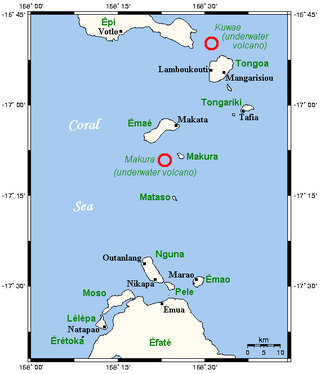
Kuwae was a landmass that existed in the vicinity of Tongoa and was destroyed by volcanic eruption in fifteenth century, probably through caldera subsidence. The exact location of the caldera is debated. A submarine caldera, now known as Kuwae caldera that is located between the Epi and Tongoa islands is a potential candidate. Kuwae Caldera cuts through the flank of the Tavani Ruru volcano on Epi and the northwestern end of Tongoa. Another potential candidate is a proposed caldera between Tongoa and Tongariki.

Stratospheric aerosol injection is a proposed method of solar geoengineering to reduce global warming. This would introduce aerosols into the stratosphere to create a cooling effect via global dimming and increased albedo, which occurs naturally from volcanic winter. It appears that stratospheric aerosol injection, at a moderate intensity, could counter most changes to temperature and precipitation, take effect rapidly, have low direct implementation costs, and be reversible in its direct climatic effects. The Intergovernmental Panel on Climate Change concludes that it "is the most-researched [solar geoengineering] method, with high agreement that it could limit warming to below 1.5 °C (2.7 °F)." However, like other solar geoengineering approaches, stratospheric aerosol injection would do so imperfectly and other effects are possible, particularly if used in a suboptimal manner.

This timeline of volcanism on Earth includes a list of major volcanic eruptions of approximately at least magnitude 6 on the Volcanic explosivity index (VEI) or equivalent sulfur dioxide emission during the Quaternary period. Other volcanic eruptions are also listed.
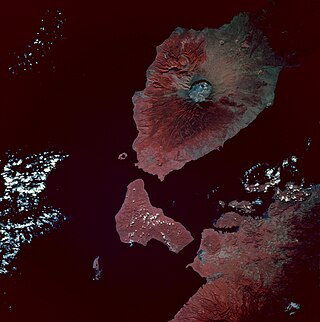
Mount Tambora is a volcano on the island of Sumbawa in present-day Indonesia, then part of the Dutch East Indies, and its 1815 eruption was the most powerful volcanic eruption in recorded human history. This volcanic explosivity index (VEI) 7 eruption ejected 37–45 km3 of dense-rock equivalent (DRE) material into the atmosphere, and was the most recent confirmed VEI-7 eruption.
Tectonic–climatic interaction is the interrelationship between tectonic processes and the climate system. The tectonic processes in question include orogenesis, volcanism, and erosion, while relevant climatic processes include atmospheric circulation, orographic lift, monsoon circulation and the rain shadow effect. As the geological record of past climate changes over millions of years is sparse and poorly resolved, many questions remain unresolved regarding the nature of tectonic-climate interaction, although it is an area of active research by geologists and palaeoclimatologists.

The 1808 mystery eruption is one or potentially multiple unidentified volcanic eruptions that resulted in a significant rise in stratospheric sulfur aerosols, leading to a period of global cooling analogous to the Year Without a Summer in 1816.
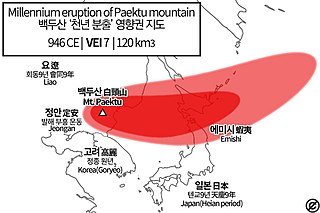
The 946 eruption of Paektu Mountain in Korea and China, also known as the Millennium Eruption or Tianchi eruption, was one of the most powerful volcanic eruptions in recorded history and is classified as a VEI-6 event. The eruption resulted in a brief period of significant climate change in Manchuria. The eruption occurred in late 946 CE.
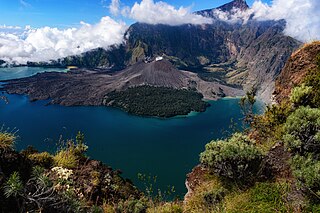
In 1257, a catastrophic eruption occurred at Samalas, a volcano on the Indonesian island of Lombok. The event had a probable Volcanic Explosivity Index of 7, making it one of the largest volcanic eruptions during the Holocene epoch. It left behind a large caldera that contains Lake Segara Anak. Later volcanic activity created more volcanic centres in the caldera, including the Barujari cone, which remains active.
There are two large sulfate spikes caused by mystery volcanic eruptions in the mid-1400s: the 1452/1453 mystery eruption and 1458 mystery eruption. Before 2012, the date of 1458 sulfate spike was incorrectly assigned to be 1452 because previous ice core work had poor time resolution. The exact location of this eruption is uncertain, but possible candidates include the submerged caldera of Kuwae in the Coral Sea, Mount Reclus and Tofua caldera. The eruption is believed to have been VEI-7.
Laika is a small uninhabited island in the Pacific Ocean, a part of the Shepherd Islands archipelago in the Shefa Province of Vanuatu.

Mount Berlin is a glacier-covered volcano in Marie Byrd Land, Antarctica, 100 kilometres (62 mi) from the Amundsen Sea. It is a roughly 20-kilometre-wide (12 mi) mountain with parasitic vents that consists of two coalesced volcanoes: Berlin proper with the 2-kilometre-wide (1.2 mi) Berlin Crater and Merrem Peak with a 2.5-by-1-kilometre-wide crater, 3.5 kilometres (2.2 mi) away from Berlin. The summit of the volcano is 3,478 metres (11,411 ft) above sea level. It has a volume of 200 cubic kilometres (48 cu mi) and rises from the West Antarctic Ice Sheet. It is part of the Marie Byrd Land Volcanic Province. Trachyte is the dominant volcanic rock and occurs in the form of lava flows and pyroclastic rocks.
References
- 1 2 3 Plummer, Christopher T.; Curran, M. A. J.; van Ommen, Tas D.; Rasmussen, S.O.; Moy, A. D.; Vance, Tessa R.; Clausen, H. B.; Vinther, Bo M.; Mayewski, P. A. (1 May 2012). "An independently dated 2000-yr volcanic record from Law Dome, East Antarctica, including a new perspective on the dating of the c. 1450s eruption of Kuwae, Vanuatu". Climate of the Past Discussions. 8: 1567–1590. doi: 10.5194/cpd-8-1567-2012 .
- 1 2 3 4 Cole-Dai, Jihong; Ferris, David G.; Lanciki, Alyson L.; Savarino, Joël; Thiemens, Mark H.; McConnell, Joseph R. (17 July 2013). "Two likely stratospheric volcanic eruptions in the 1450s C.E. found in a bipolar, subannually dated 800 year ice core record". Journal of Geophysical Research: Atmospheres. 118 (14): 7459–7466. Bibcode:2013JGRD..118.7459C. doi: 10.1002/jgrd.50587 . S2CID 129790360.
- ↑ Briffa, K. R.; Jones, P. D.; Schweingruber, F. H.; Osborn, T. J. (1998). "Influence of volcanic eruptions on Northern Hemisphere summer temperature over the past 600 years" . Nature. 393 (6684): 450–455. Bibcode:1998Natur.393..450B. doi:10.1038/30943. ISSN 1476-4687. S2CID 4392636.
- ↑ Miller, Gifford H.; Geirsdóttir, Áslaug; Zhong, Yafang; Larsen, Darren J.; Otto-Bliesner, Bette L.; Holland, Marika M.; Bailey, David A.; Refsnider, Kurt A.; Lehman, Scott J.; Southon, John R.; Anderson, Chance; Björnsson, Helgi; Thordarson, Thorvaldur (2012). "Abrupt onset of the Little Ice Age triggered by volcanism and sustained by sea-ice/ocean feedbacks: LITTLE ICE AGE TRIGGERED BY VOLCANISM". Geophysical Research Letters. 39 (2): n/a. doi: 10.1029/2011GL050168 . S2CID 15313398.
- ↑ Ruth, U.; Barnola, J.-M.; Beer, J.; Bigler, M.; Blunier, T.; Castellano, E.; Fischer, H.; Fundel, F.; Huybrechts, P.; Kaufmann, P.; Kipfstuhl, S.; Lambrecht, A.; Morganti, A.; Oerter, H.; Parrenin, F. (7 August 2007). ""EDML1": a chronology for the EPICA deep ice core from Dronning Maud Land, Antarctica, over the last 150 000 years". Climate of the Past. 3 (3): 475–484. Bibcode:2007CliPa...3..475R. doi: 10.5194/cp-3-475-2007 . ISSN 1814-9324. S2CID 131418894.
- ↑ Gao, Chaochao; Robock, Alan; Self, Stephen; Witter, Jeffrey B.; Steffenson, J. P.; Clausen, Henrik Brink; Siggaard-Andersen, Marie-Louise; Johnsen, Sigfus; Mayewski, Paul A.; Ammann, Caspar (2006). "The 1452 or 1453 A.D. Kuwae eruption signal derived from multiple ice core records: Greatest volcanic sulfate event of the past 700 years". Journal of Geophysical Research. 111 (D12): D12107. Bibcode:2006JGRD..11112107G. doi: 10.1029/2005JD006710 . ISSN 0148-0227.
- 1 2 3 Sigl, Michael; McConnell, Joseph R.; Layman, Lawrence; Maselli, Olivia; McGwire, Ken; Pasteris, Daniel; Dahl-Jensen, Dorthe; Steffensen, Jørgen Peder; Vinther, Bo; Edwards, Ross; Mulvaney, Robert; Kipfstuhl, Sepp (16 February 2013). "A new bipolar ice core record of volcanism from WAIS Divide and NEEM and implications for climate forcing of the last 2000 years: A 2000YR BIPOLAR VOLCANO RECORD". Journal of Geophysical Research: Atmospheres. 118 (3): 1151–1169. doi:10.1029/2012JD018603. S2CID 130773456.
- ↑ Cole-Dai, Jihong; Ferris, David G.; Lanciki, Alyson L.; Savarino, Joël; Thiemens, Mark H.; McConnell, Joseph R. (27 July 2013). "Two likely stratospheric volcanic eruptions in the 1450s C.E. found in a bipolar, subannually dated 800 year ice core record: TWO VOLCANIC ERUPTIONS IN THE 1450s". Journal of Geophysical Research: Atmospheres. 118 (14): 7459–7466. Bibcode:2013JGRD..118.7459C. doi: 10.1002/jgrd.50587 . S2CID 129790360.
- ↑ Abbott, Peter M.; Plunkett, Gill; Corona, Christophe; Chellman, Nathan J.; McConnell, Joseph R.; Pilcher, John R.; Stoffel, Markus; Sigl, Michael (4 March 2021). "Cryptotephra from the Icelandic Veiðivötn 1477 CE eruption in a Greenland ice core: confirming the dating of volcanic events in the 1450s CE and assessing the eruption's climatic impact". Climate of the Past. 17 (2): 565–585. Bibcode:2021CliPa..17..565A. doi: 10.5194/cp-17-565-2021 . ISSN 1814-9324. S2CID 233267071.
- ↑ Sigl, Michael; Toohey, Matthew; McConnell, Joseph R.; Cole-Dai, Jihong; Severi, Mirko (12 July 2022). "Volcanic stratospheric sulfur injections and aerosol optical depth during the Holocene (past 11500 years) from a bipolar ice-core array". Earth System Science Data. 14 (7): 3167–3196. Bibcode:2022ESSD...14.3167S. doi: 10.5194/essd-14-3167-2022 . ISSN 1866-3516.
- ↑ Sigl, Michael; Toohey, Matthew; McConnell, Joseph R.; Cole-Dai, Jihong; Severi, Mirko (2 March 2021). "HolVol: Reconstructed volcanic stratospheric sulfur injections and aerosol optical depth for the Holocene (9500 BCE to 1900 CE)". Pangaea. doi:10.1594/PANGAEA.928646.
- ↑ Lavigne, F.; Degeai, J.-P.; Komorowski, J.-C.; Guillet, S.; Robert, V.; Lahitte, P.; Oppenheimer, C.; Stoffel, M.; Vidal, C. M.; Surono; Pratomo, I. (15 October 2013). "Source of the great A.D. 1257 mystery eruption unveiled, Samalas volcano, Rinjani Volcanic Complex, Indonesia". Proceedings of the National Academy of Sciences. 110 (42): 16742–16747. Bibcode:2013PNAS..11016742L. doi: 10.1073/pnas.1307520110 . ISSN 0027-8424. PMC 3801080 . PMID 24082132.
- ↑ Miller, G. H.; et al. (31 January 2012). "Abrupt onset of the Little Ice Age triggered by volcanism and sustained by sea-ice/ocean feedbacks". Geophysical Research Letters. 39 (2). doi: 10.1029/2011GL050168 .
- ↑ Esper, Jan; Büntgen, Ulf; Hartl-Meier, Claudia; Oppenheimer, Clive; Schneider, Lea (6 May 2017). "Northern Hemisphere temperature anomalies during the 1450s period of ambiguous volcanic forcing". Bulletin of Volcanology. 79 (6): 41. Bibcode:2017BVol...79...41E. doi:10.1007/s00445-017-1125-9. ISSN 1432-0819. S2CID 133844199.
- ↑ "For immediate release" (Press release). NASA Jet Propulsion Laboratory. 6 December 1993. Retrieved 2 April 2022.
- ↑ Therrell, Matthew; Stahle, David W.; Soto, Rodolfo Acuña (2004). "Aztec Drought and the 'Curse of One Rabbit'". Bulletin of the American Meteorological Society. 85 (9): 1263–1272. Bibcode:2004BAMS...85.1263T. doi: 10.1175/BAMS-85-9-1263 . S2CID 123560837.